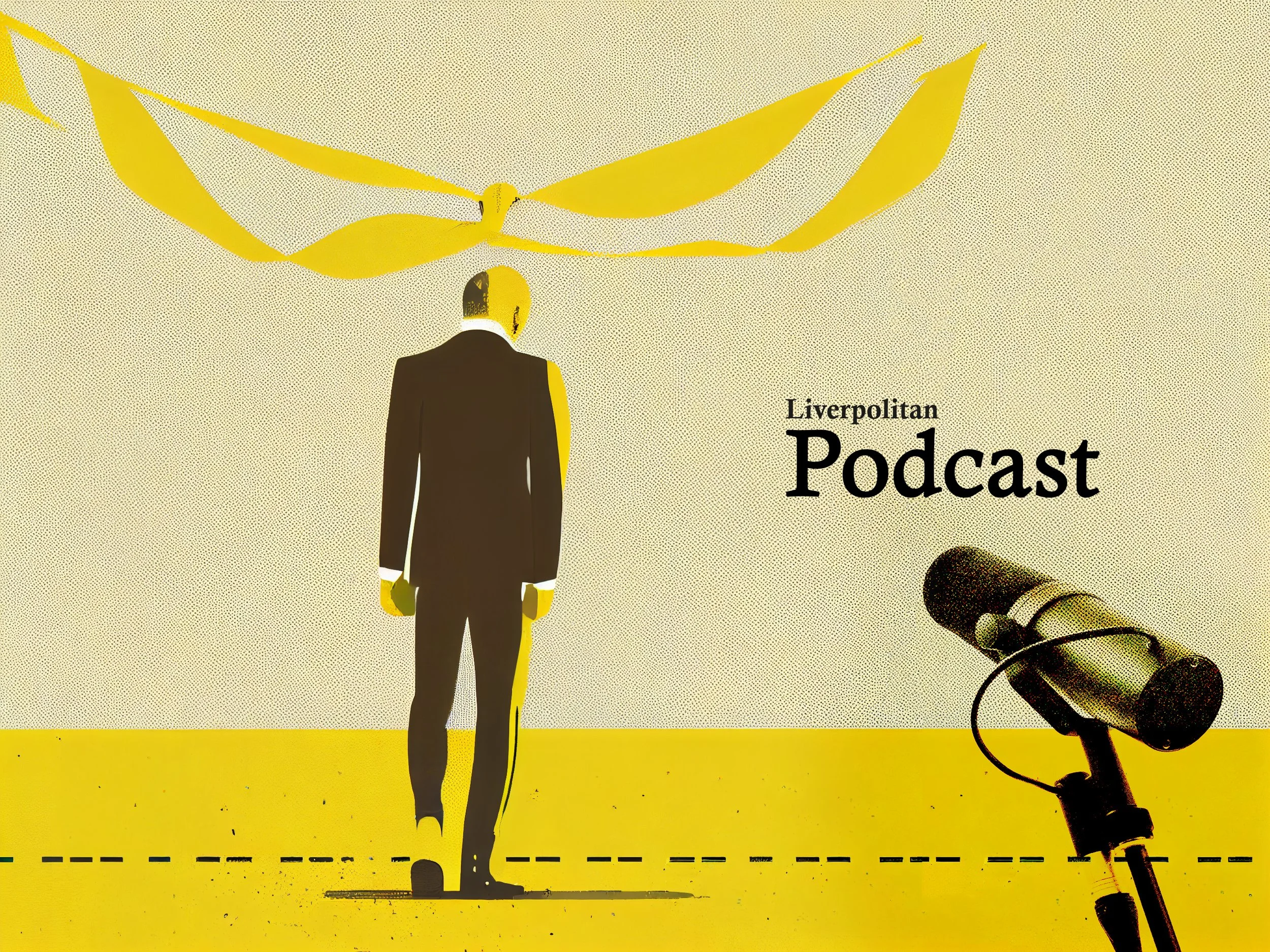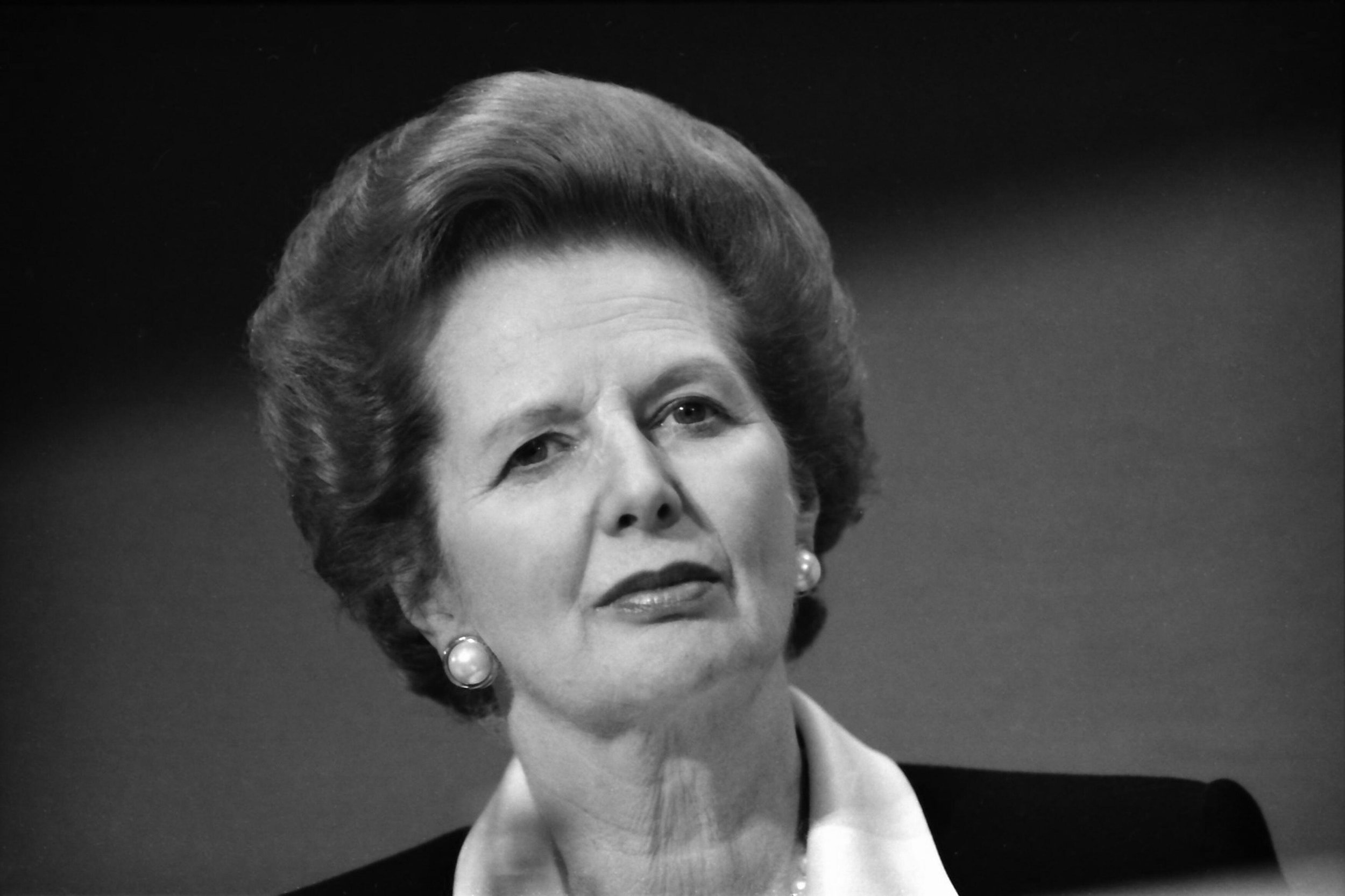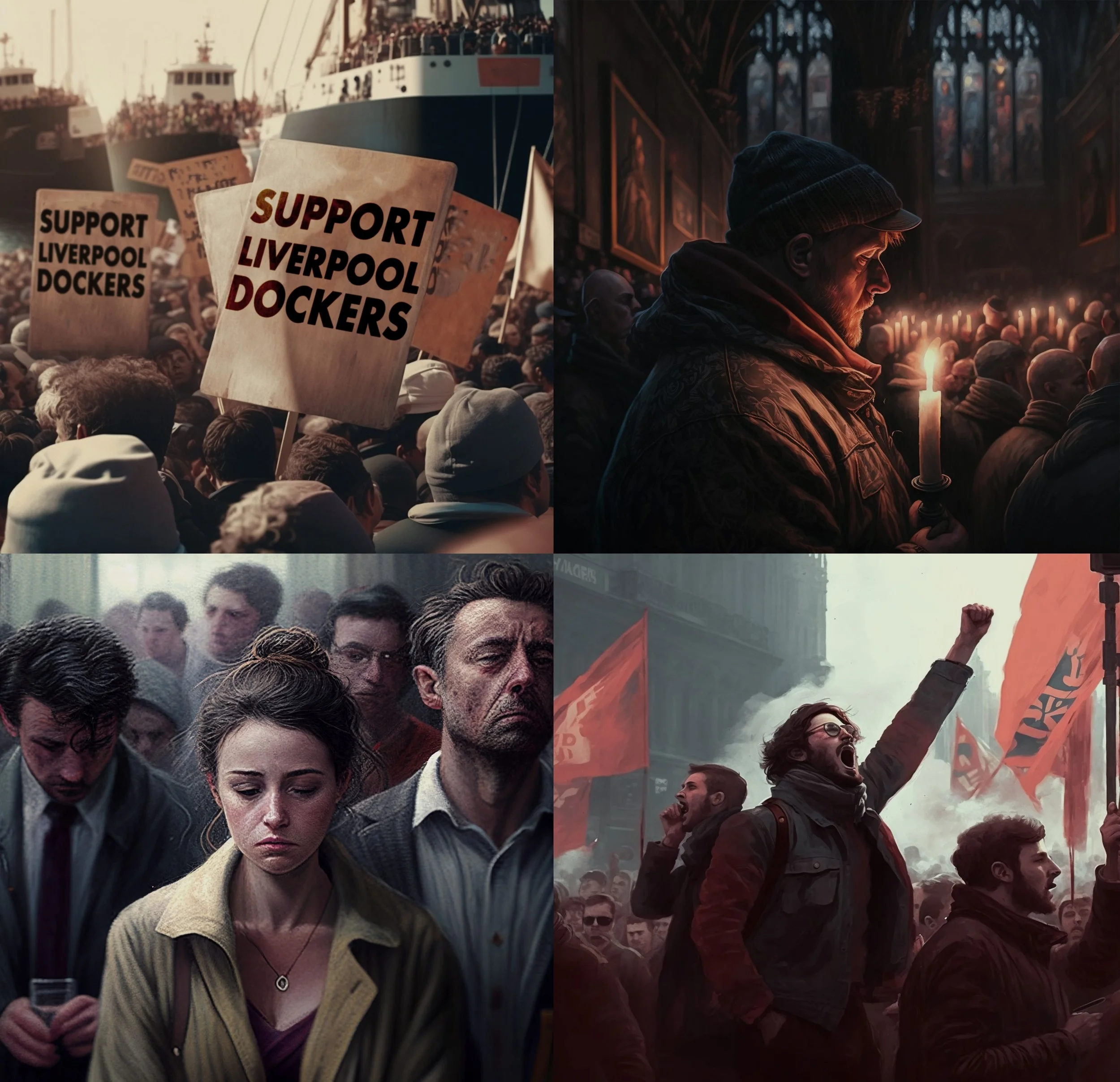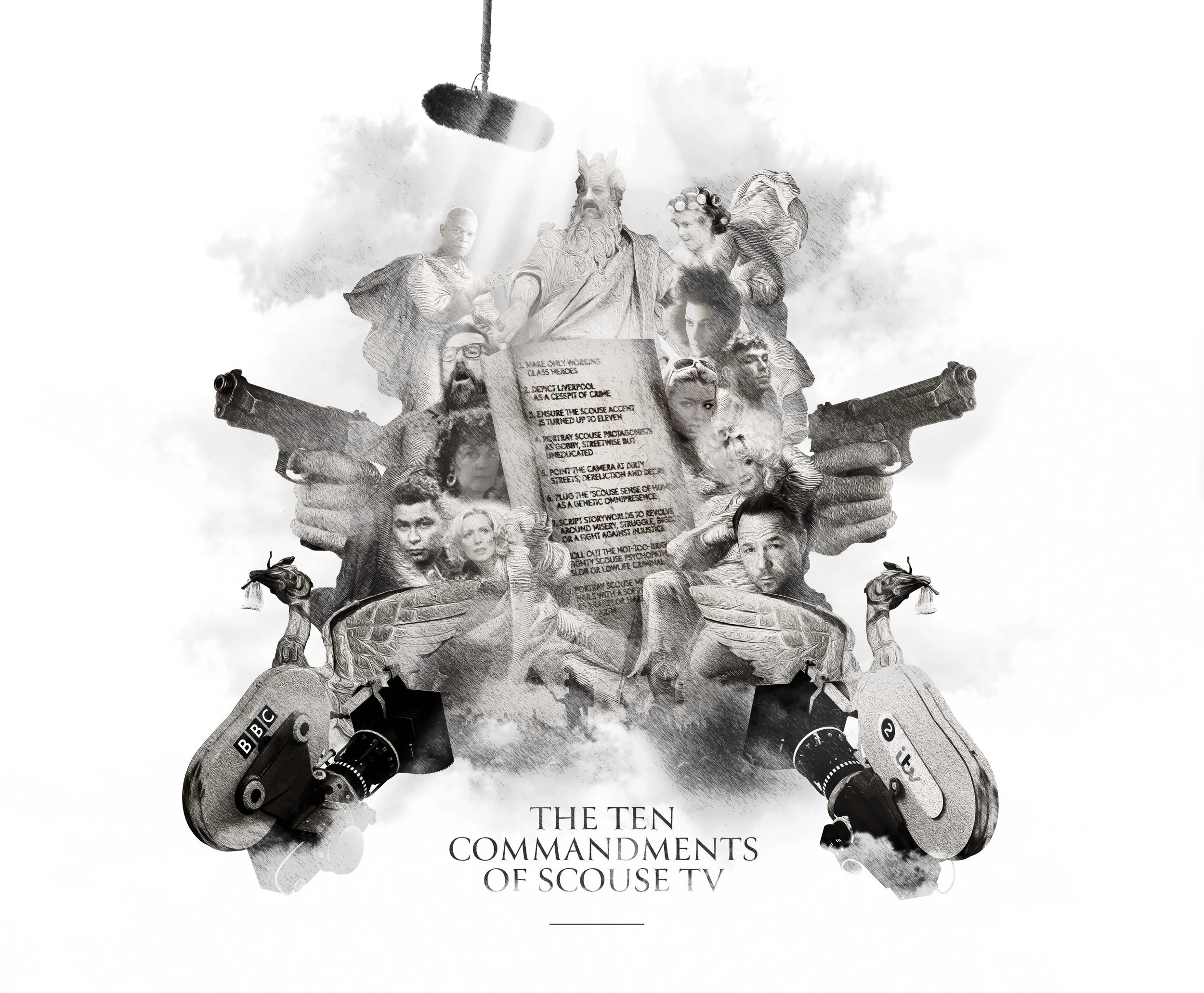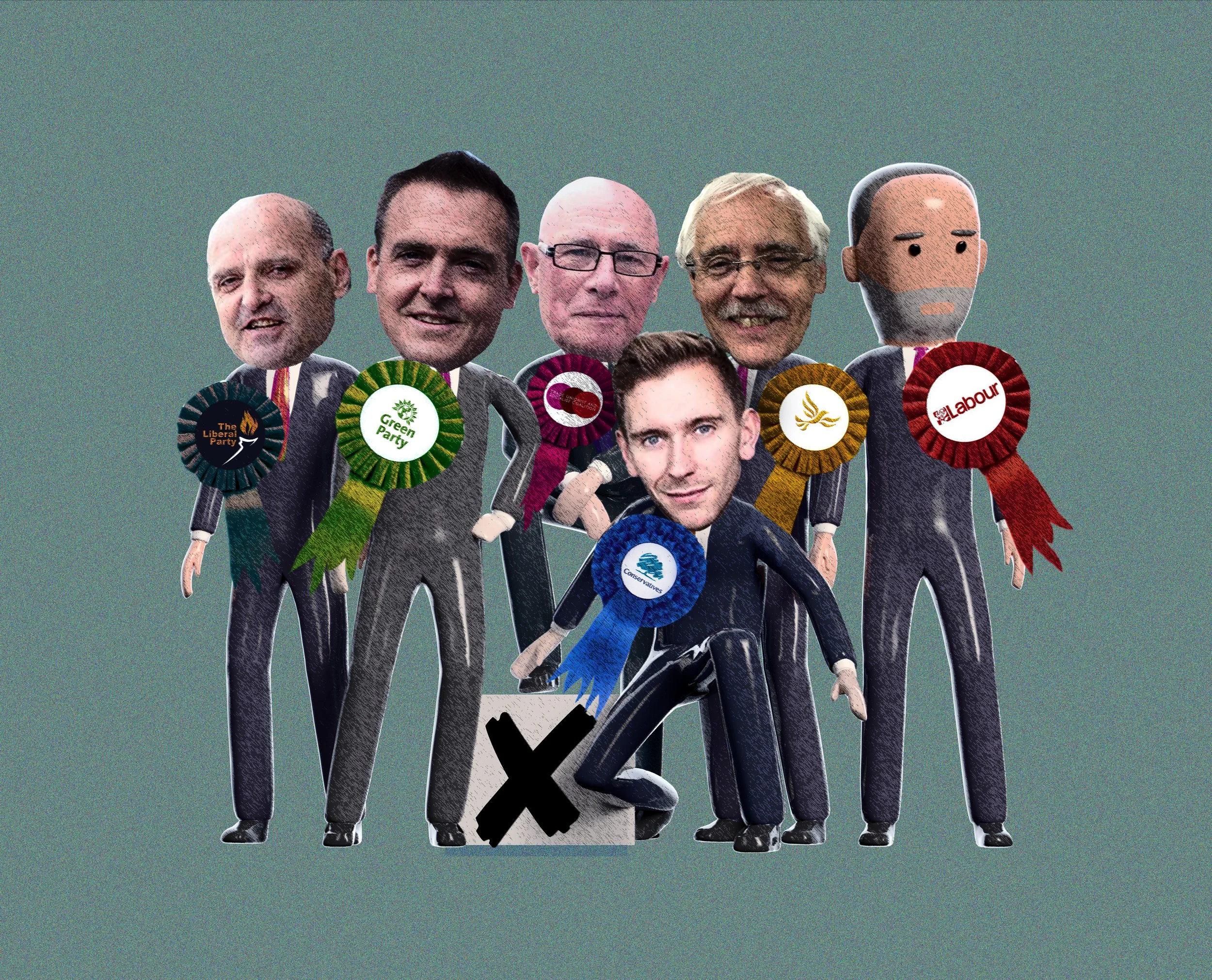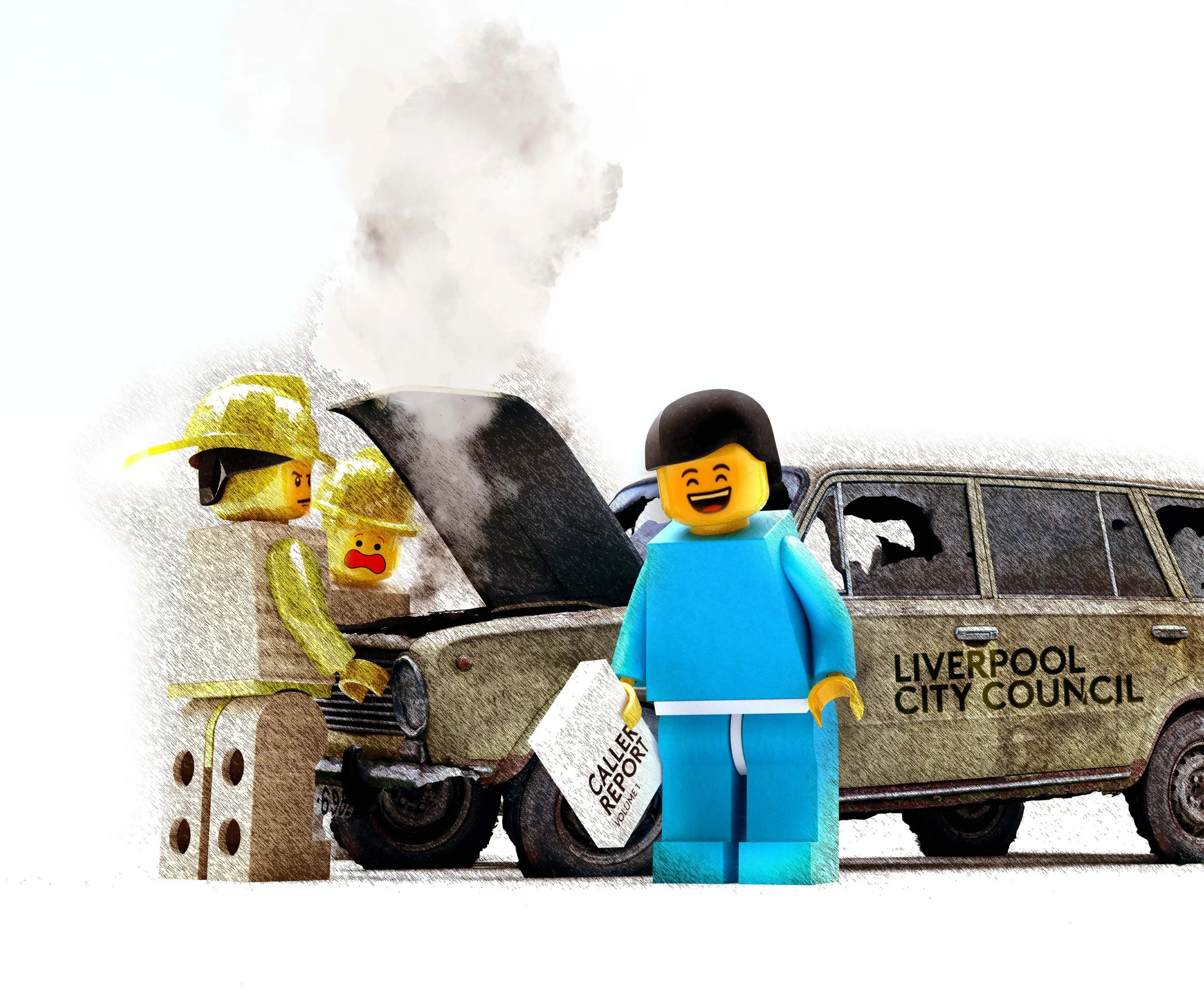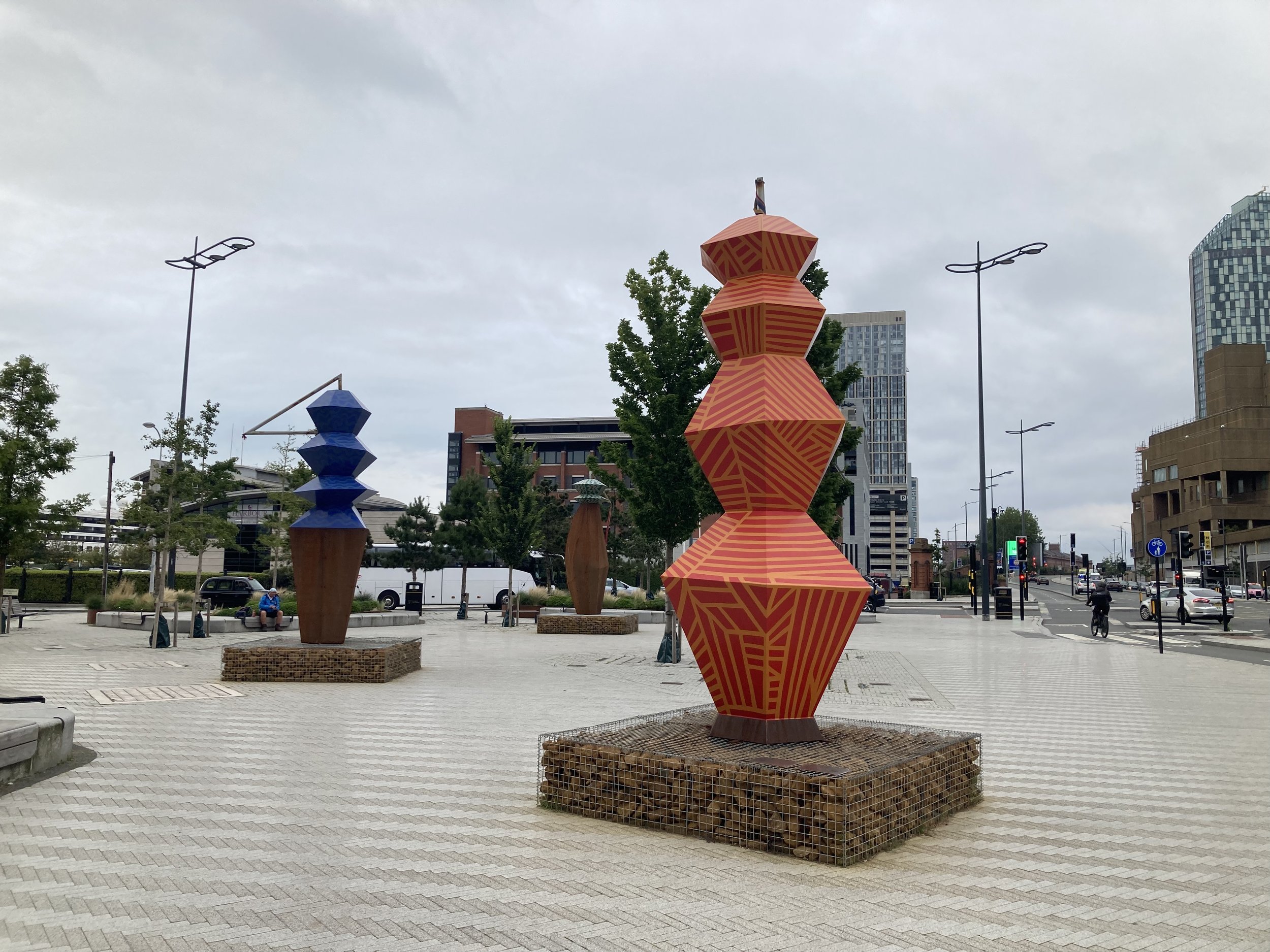Recent features
Public Art is Dead. Long Live Culture.
Liverpool has a complex relationship with its Art. Priding itself on its cultural credentials and home to the Liverpool Biennial art exhibition, yet its institutions tend to measure Art’s value in the spreadsheet metrics of the philistine. As our publicly commissioned pieces become ever more disposable, sanitised and inoffensive, art historian Ed Williams asks whether Liverpool is the place where art comes to die?
Ed Williams
Fifteen years have elapsed since Liverpool was honoured with the title European Capital of Culture, and with the help of constant repetition, the city’s status as a ‘Cultural City’ has been cemented within the popular consciousness, at least locally, if not always universally. But what, if anything, does this accolade mean today? And how do we stop it being just a meaningless marketing label, presuming it was ever more than that to start off with?
Culture, or at least a certain type of culture, is like universal health care and compulsory education often viewed as an indisputable social good – a life enhancer that with official state sanction became a defining feature of Britain’s Post-War project to improve the lives of its population. But culture is an elusive quarry - challenging to define, let alone to quantify within a framework of metrics. Unlike healthcare, culture does not ‘treat’ or ‘heal’ in a way that lends itself to spreadsheet evaluation. Nevertheless, a consensus of bien pensantism has coalesced around the importance of culture, invariably focusing less on its intrinsic and frustratingly wishy-washy, hard to define benefits and more on its ability to generate economic returns – something our civic leaders and purse-string holders can feel confident about putting on a press release. As a result, we’ve all become familiar with hearing how some new cultural initiative will add value to the local economy increase visitor spend, improve hotel occupancy rates, and create and sustain those all-important X number of jobs. We understand why these arguments predominate, but accusations of philistinism aside, the true purpose of culture seems to lie elsewhere.
These statistics, often quoted as culture’s most manifest benefit, highlight a fundamental point. In Britain’s post-industrial society, culture is increasingly what economic output looks like. The service sector is the prime employer, and culture is a branch of this sector. That’s why the leaders of our cultural institutions increasingly seem to resemble business men and women rather than merely champions of the arts. Or at least, they certainly have to moderate their artistic passions behind drier, more utilitarian language. The managers of a museum or art gallery may have more in common with that of a hotel or restaurant than is perhaps initially recognised, being equally concerned as they are with customer satisfaction, visitor throughput and money spent.
“A consensus of bien pensantism has coalesced around the importance of culture, focusing less on its intrinsic and frustratingly wishy-washy, hard to define benefits and more on its ability to generate economic returns.”
What one could colloquially call the ‘Cultural Economy’ argument may then explain the need among those, both in government and in the arts, to continually re-iterate the significance of Liverpool’s cultural status. After all, if we weren’t so economically desperate, perhaps there would be more willingness to talk about culture in its own terms and less need to worry about the financial side-benefits? In the absence of much else to shout about, continuously asserting the city’s cultural status becomes a proxy for saying we’re still here, we’re still relevant, we still have a future. It’s also jolly useful for any politicians keen to show they are making good decisions in a challenging environment.
Despite this, the inquisitive might well ask if this is all there is to ‘Culture? Is there anything beyond the reductivism of the bottom line? And if there is, how do we gauge it?
Beyond hosting prestigious events such as the recent Eurovision Song Contest Final, more recent efforts to assert Liverpool’s cultural status appear to focus on the commissioning of works of public art, such as Alicja Biala’s Merseyside Totemy (2022) and, more recently, those unveiled as part of this year’s Liverpool Biennial, including Rudy Loewe’s The Reckoning (2023) and Nicholas Galanin’s Threat Return (2023). These totemic pieces, no pun intended, now seemingly serve as cultural barometers through which our city’s cultural status appears to be discerned. Behold people of Liverpool, this is culture!
Black Power. Exploring ‘hot’ issues in inoffensive ways. Rudy Loewe, The Reckoning, 2023. Photograph by Rob Battersby, courtesy of Liverpool Biennial.
The result of this approach is an ever-increasing amount of public art on display. Whilst prima facie positive, the fact remains that the burgeoning number of works is so great, it is becoming an increasing challenge to maintain an accurate count; and to attend to their continued preservation and maintenance. But then maintenance no longer seems to be part of the brief.
Instead, in an Age of Austerity, public art is commissioned, paid for, put on display for a short time, and there the liability typically ends, with the item often all too swiftly packed up and removed to some mysterious warehouse/bonfire in the sky as if it never really existed – outside of a few pictures on the internet. This is Art transformed into fast moving consumer goods, less a vision for the ages cast in marble and more a plastic bag flapping in the wind. This hard-nosed economic reality may well explain why so many of the recent commissions have only a temporary status within the city. For example, as things stand, Alicja Biala’s Merseyside Totemy will be removed at some point in 2024.
Could this new approach to a work’s lifespan be a consequence of the fact that older pieces have been left to their own devices? Betty Woodman’s Liverpool Fountain (2016) looks to be in a forlorn state, with water flowing only occasionally. Stephen Broadbent’s beautiful and powerful Reconciliation (1) (1990) is blighted by the twin plagues of graffiti and adhesive stickers.
“In an Age of Austerity, public art is all too swiftly packed up and removed to some mysterious warehouse/bonfire in the sky as if it never really existed. This is Art transformed into fast moving consumer goods, less a vision for the ages cast in marble and more a plastic bag flapping in the wind.”
A cynic might surmise that this is an attempt to manifest ‘culture on the cheap’, far removed from the initial spirit with which Public Art was originally conceived in the immediate Post-War period. These works from the 1950s and early 1960s, originating at a time of greater optimism, represented egalitarian attempts to bring art to the wider public, away from the confining and often restrictive environs of museums and galleries. Typically, it was art designed to uplift the spirits. This was how the work of Moore, Hepworth, Epstein and Paolozzi, amongst others, became better known and appreciated by the non-gallery attending public. It was this zeitgeist of civic ambition and new hope that Jacob Epstein sought to depict in his iconic Liverpool Resurgent (1956) which still stands proudly defiant above the main entrance of the former Lewis’ department store. Later works such as Richard Huws’ cheerful kinetic sculpture, the Piazza Fountain(1967), more commonly known as the ‘Bucket Fountain’, were attempts to create a sense of place in an otherwise rather anonymous space. This second generation of works, beginning in the late 1960s, were also conceived as catalysts for development, particularly during the economic dark days of the 1980s and 1990s. They may be considered as examples of the role of public art in regenerating neighbourhoods and communities. Superlative pieces such as Charlotte Meyer’s Sea Circle (1984) and Tony Cragg’s Raleigh (1986) are stand out examples of British Postmodern sculpture at its best.
Cryptic. Visualising climate data to make it ‘accessible’. But can you trigger a conversation if no-one knows what you are talking about? Alicja Biala, Merseyside Totemy, 2022. Commissioned by Liverpool Biennial & Liverpool BID Company. Photograph: Ed Williams.
In more recent years, works have been commissioned by various bodies, including the Liverpool Biennial and Liverpool BID Company. Such is the abundance of these new works it would appear each year heralds at least one new unveiling. But is this merely art for art’s sake? Or does this reflect a wider desire to decorate the city with public art and thereby turn the urban environment into an open air gallery of temporary works? Whatever the motivation, the result appears to be a confusing array of pieces, revealed with some fanfare and then seemingly allowed to decay through neglect or indifference. The casual observer could be excused for concluding that Liverpool is a city where public art comes to die, discarded and left as litter like so many broken domestic appliances. Is this seeming lack of care evidence of a wider malaise within Liverpool’s cultural sector? Is it a failure to fully appreciate that a cultural legacy necessitates ‘after care’? Or does it merely reflect a changing view of art as temporary and disposable? Perhaps we no longer feel able to commit to ideas in the same way – our art like our views increasingly contingent and subject to new interpretations. Are older works, such as Carlos Cruz-Diez’ Induction Chromatique a Double Frequence pour L’Edmund Gardner Ship (2014) – that remarkable dazzle ship - now mere historic footnotes? Having been re-painted, all that remains of Carlos’ work is a small weather beaten placard. I can’t help wondering whether our seemingly endless obsession with the ever elusive avant garde, makes consideration of the established, the old and the familiar now anathema?
This focus on the temporary and the cheap may be the avowed intention of those who commission Liverpool’s contemporary public art, but a critical eye cast over recent works would conclude that they offer little to truly spark the imagination. These pieces provide not the ‘shock of the new’, but rather a dull blandness, resulting in a series of indifferent works which seemingly seek to please only the passing tourist and the selfie hunter. Consider for a moment, Ugo’s Liverpool Mountain, a vertically stacked tower of candy coloured stone blocks placed prominently at the Albert Dock. Whilst initially amusing, and you could argue eye-catching against the uniformity of the dock’s red-brick warehouses, it hardly moves one to further contemplation. But perhaps more importantly in a clear nod to modern sensibilities, neither does it offend anyone. This is Art as Entertainment. Seen, consumed and then forgotten.
“The dissonance between the pretensions of the explanatory labels and the works themselves is a gaping chasm. Alicja Biala’s sculptures are supposedly an attempt to visualise climate data, but you can’t spark a conversation if no-one knows what you are talking about.”
Even commissions which claim to have a more intellectually challenging agenda often fall short. The current Liverpool Biennial includes pieces which address hot button concerns such as race relations, social inequality and climate change, but these works only explore these issues in the most convoluted or inoffensive ways, often leaving the viewer unengaged, bemused or, at best, just happy to have themselves photographed next to a decorative work. The dissonance between the pretensions of the explanatory labels and the works themselves is a gaping chasm. Alicja Biala’s 2022 piece, Merseyside Totemy is a case in point. Only by reading the artist’s explanation or some earnest review in the nationals could you guess at the message. These sculptures are supposedly an attempt to visualise climate data, which we are told can often seem too ‘academic and theoretical’. But au contraire – they are the very example of clarity compared to these cryptic albeit pretty land buoys. You can’t spark a conversation if no-one knows what you are talking about.
Eleng Luluan’s, Ngialibalibade to the Lost Myth, 2023 is highly decorative but does it challenge the mind? Photograph by Ed Williams.
Rudy Loewe, The Reckoning, 2023 is another example of an attempt to make a serious point in an inoffensive way. Rudy’s original work was a far more powerful meditation on the injustices of British colonialism and a celebration of the 1970 Black Power Trinidadian Revolution. Yet this Biennial piece with its pink, orange and cyan stilt walkers just looks ‘funny’. But perhaps the award for the least engaging work should go to Eleng Luluan with her Ngialibalibade to the Lost Myth, 2023. According to the official spiel, ‘Ngialibalibade’ describes ‘the growth of life, the transformation of the soul, the change in nature, the rapid development of technology, the noticeable changes in life, or the subtle ones hiding in our hearts.’ Make of that what you will. It’s claimed the work has something to do with landslides in Taiwan and their power to upend ‘culture’. Though why culture rather than life should be emphasised is curious. Either way, its pottery jar made of fishing nets is remarkable more for its decorative qualities than its ability to provoke meditation on humanity’s relationship with nature. Still, at least it helps to mitigate the torpor elicited by the architecture of Princess Dock.
Surely culture must mean more than this? If the power of art stems from its ability to move, provoke or encourage us, then it must do more than merely act as decoration. Does this malign trend towards the banal and the superficial herald the craven surrender of those in leadership roles within the city’s cultural institutions to eliminate the alleged activism of art? Is this a reaction to the supposed ‘culture wars’ so obsessively reported on by the political right? Or can public art now only ever be commissioned if it is considered ‘safe’, inoffensive, and non-challenging? A small number of indifferent pieces may be forgiven, but the sheer abundance of such bland works seems anathema to the professed aims of public art.
“Perhaps we no longer feel able to commit to ideas in the same way – our art like our views increasingly contingent and subject to new interpretations.”
Forlorn. Betty Woodman, Liverpool Fountain, 2016. “The casual observer could be excused for concluding that Liverpool is a city where public art comes to die.” Photograph by Ed Williams.
I challenge those that cling to the illusion, with respect to public art, that ‘more is more’ in perpetuating Liverpool’s status as a ‘Cultural City’. Just as the European Union’s ever expanding list of cultural capitals – now an increasingly unexclusive club of 78 - tends to devalue the idea of the exceptional, so Liverpool must pay greater heed to what is valuable or risk swamping the quality it does possess in a sea of disposable superficiality. Or worse, lose its ability altogether to distinguish between what is good and what is not. If it is to be more than just an empty slogan, being a cultural capital should act as a rallying call to better appreciate the truly wonderful works we have and to consider commissioning pieces which truly reflect the dynamic power of art.
This is not an argument for ‘less is more’ – rather an entreaty to maintain the important works of public art that we already possess and to focus new commissions on truly ground breaking and lasting works for the people of Liverpool. This should be the real legacy of our City of Culture status.
Ed Williams is an Academic Art Historian who works for TATE Liverpool in the Visitor Experience team. He is a member of the International Association of Art Critics (AICA) and he teaches the History of Art at the University of Liverpool.
Ed is currently running a 5-week course at the University of Liverpool entitled 'How to Understand Art' starting in October 2023. For more details on enrolment click here.
Main image: Ugo Rondinone, Liverpool Mountain (2018). Photograph by Ed Williams.
Share this article
What do you think? Let us know.
Write a letter for our Short Reads section, join the debate via Twitter or Facebook or just drop us a line at team@liverpolitan.co.uk
The Beatles: Inspiration or dead weight?
When does city pride in the Fab Four turn into a hindrance to future achievement? Jon Egan argues that the city of Liverpool is in danger of becoming a Beatles theme park, and its world conquering band a crutch to exorcise the painful intimations of our diminished relevance and prestige. In looking to the past, have we forgotten what made John, Paul, George and Ringo so special - their fearless embrace of the avant-garde, the contemporary and the new?
Jon Egan
There was something profoundly true and desperately sad in University of Liverpool lecturer, Dr David Jeffery's acerbic observation that "Liverpool is a Beatles' shrine with a city attached."
It is the dispiriting obverse to music journalist, Paul Morley's rhapsodic description of Liverpool as "a provincial city plus hinterland with associated metaphysical space as defined by dramatic moments in history, emotional occasions and general restlessness."
Jeffery's comments on Twitter appear to have been inspired or provoked by the recent announcement that Liverpool would be using a £2 million grant from Government to advance the business case for yet another "world-class" and "cutting-edge" Beatles' attraction on our hallowed waterfront. Presumably, it will be sandwiched somewhere between the Beatles statue and The Beatles Experience and conveniently close to The Museum of Liverpool and The British Music Experience with their not inconsiderable collections of Beatles artifacts and memorabilia. The exact nature of this new cultural icon remains a little unclear, however, amidst wildly differing descriptions offered by our City and Metro Mayors.
What is deeply depressing about this announcement is that it suggests that Liverpool is incapable of imagining any kind of cultural proposition that is not predicated on the seemingly inexhaustible allure of the four boys who shook the world.
There is of course a readily available and seemingly plausible justification for the never-ending Beatles' fetish, and that is the claim that they are the anchor for our hugely important tourism economy. Notwithstanding the implication that David Jeffery is right to suspect that the city is consciously morphing into a Fab Four theme park, I suspect that this is not exactly the whole truth. For Liverpool, The Beatles are a crutch, a cherished emblem of identity and importance used to exorcise painful intimations of diminished relevance and prestige.
In the novel, Immortality, Czech writer Milan Kundera tells the story of the man who fell over in the street, who on his way home stumbles on an uneven pavement, falls to the ground and arises dazed, grazed and dishevelled, but after a few moments composes himself, and gets on with his life. But unbeknown to the man, a world famous photographer happens to witness the scene and quickly snaps an image of the bewildered and bloodied pedestrian. He subsequently decides to make this picture the cover image for his new book and the poster for his international exhibition. For the man, a momentary misfortune freeze-framed, replicated and disseminated across the world, becomes the image that will forever define who he is.
The more we conflate the Beatles brand with the city's identity, the less space we have to imagine anything original, contemporary or remarkable.
In a sense, Liverpool is the City that fell over on the street, our external image is in significant part, defined by a succession of misfortunes, afflictions and tragedies that befell the city over two decades at the end of the last century. These events forged images, preconceptions and stereotypes that still blight us today and have never been successfully exorcised or replaced.
The Beatles hark back to a time before this blight, when Liverpool was in Alan Ginsberg's celebrated phrase, "the centre of consciousness of the human universe." They are, I believe, a therapeutic distraction from the task of making a different story or discovering a new identity.
Culturally, our Beatles fixation is unhealthy, debilitating and regressive. In fact, I fear we are reaching a point where The Beatles will become the single biggest impediment to any form of civic progression, or any serious project to make Liverpool important, interesting or relevant in today's world. If we are going to have a civic conversation about what kind of "world class" Beatles attraction should be erected at The Pier Head, my immediate impulse would be to recommend a mausoleum.
But perhaps a more imaginative and original idea was the one offered by the late Tony Wilson. That supreme Mancophile, Factory Records producer, Granada TV reporter and founder of the Hacienda nightclub was never held in particularly high regard in this city, especially following some tongue in cheek words of encouragement he gave to Club Brugge on the eve of their European Cup semi-final with Liverpool in 1977. Scousers may resemble elephants with respect to their prodigious powers of memory, but our skins can sometimes be just a tiny bit thinner. Tragically, Wilson's Mancunian persona and his tendency to lapse into casual profanity whilst presenting his project to civic decision-makers proved the undoing of his brilliant and visionary proposition for POP - the International Museum of Popular Culture. Pitched as the big idea for the European Capital of Culture, and the solution that would provide content for Will Alsop's audacious but otherwise functionless Fourth Grace, POP was a talisman for instant reinvention - a Beatles-inspired attraction without any reference to The Beatles. Alas it never happened.
Wilson had first dreamt of POP as an adornment for his own native city and a fitting celebration of its notable contribution to the history of modern popular music, but he soon realised that it was the right idea for the wrong place. He would often express irritation that when travelling in the US he would frequently have to explain where Manchester was by reference to its proximity to Liverpool - a place that people had actually heard of. And there was also the grudging recognition that at a time when Liverpool was "the centre of the human universe" globalising popular culture - Manchester could only offer us Freddy and The Dreamers. Even the outrageous charisma of Manchester United football god, George Best was derivative as he was often dubbed the 5th Beatle.
POP would not simply have been about popular music, it would encompass every facet of popular culture, every expression of contemporary creativity in film, TV, advertising, games, cars, sport, fashion, digital technology and consumer culture. And it was proposed for Liverpool because this was the place that spawned a phenomenon that reached the four corners of the Earth. It was a moment when the world discovered a common currency and a cultural vernacular intelligible to every ear.
POPs content would be dynamic and ever-changing, a continuous exposition of the new, curated by global creatives, designers and technologists. It would be Liverpool recovering its world city perspective and its capacity to invent and innovate - the pool of life, the birth canal for the extraordinary and the unprecedented. Its ingenious paradox was its implicit assertion that The Beatles did not make Liverpool, but Liverpool made The Beatles.
They monopolise our self-image occluding facets of identity and history now only half-glimpsed in the penumbra of a shadowy scouse dreamtime.
All of which is a million miles from Steve Rotheram's "world-class immersive experience" which he promises us will be more spectacular than a glass cabinet containing John Lennon's underpants. We can hardly wait.
If all we can possibly imagine are The Beatles etherealised into holograms - almost literally spectres from beyond the grave - then David Jeffery is right and Liverpool's once rich and cosmopolitan culture has collapsed into a black hole of redundant clichés. The more we inflate our Beatles offer and conflate their brand with the city's very identity, the less space we have in which to imagine anything original, contemporary or remarkable. Along with football (which at least tells new stories) they have come to monopolise both our external brand and our officially curated self-image, occluding facets of our identity and history that are now forgotten and suppressed, only half-glimpsed in the penumbra of a shadowy scouse dreamtime.
The Beatles have come not only to represent our brand, but have also helped to define our personality, attitude and accent - cheeky, chippy, sassy and defiant. As emblems of the 60s social revolution, they helped to forge and reify the idea of Liverpool as a working class city - or more accurately an exclusively working class city. As rock journalist Paul duNoyer, notes in his book, Wondrous Place, this is both a false and profoundly disabling imposition. Not only, as Tony Wilson asserted, are we the city that globalised popular culture, but we are a city that has contributed massively to every facet of culture, ideas and invention over the last 200 years.
The world's first enclosed dock and inter-city railway, together with the completion of the Transatlantic telegraph cable, are not only stunning achievements in technological innovation, but bolster the credible claim that globalisation began here.
The extent to which we have been willing to squander or disown the breadth of our cultural heritage was brought home to me in the febrile final stages of the European Capital of Culture bidding competition. Having commissioned pop artist, Sir Peter Blake to create a homage to his iconic Sgt Pepper album cover to remind the world, or at least the judging panel, of Liverpool's cultural and intellectual prowess, the task of deciding who exactly was worthy of inclusion was both fraught and enormously revealing. Apart from a few contemporary, and at the time highly topical creatives including the poet Paul Farley, artist Fiona Banner and film-maker Alex Cox, the principal criterion for inclusion appeared to be the directness or intimacy of connection to The Beatles. A lop-sided bias towards musicians, popular entertainers and Sixties icons meant no room for the likes of painters George Stubbs and Augustus John, poets Nathaniel Hawthorne and Wilfred Owen, novelist Nicholas Monsarrat, playwright, Peter Shaffer or even poet and novelist, Malcolm Lowry the author of the celebrated, Under the Volcano. Incredibly, until Bluecoat Artistic Director, Bryan Biggs' finally succeeded in persuading Wirral Council to erect a blue plaque on New Brighton's sea wall, there was virtually no public recognition that one of the 20th century's greatest and most influential novelists had any association with the Liverpool City Region.
Without questioning or diminishing the impact of the Mersey Sound poets (McGough, Henri and Patten) in the 1960s, their literary status is no way comparable to another unsung and forgotten cultural luminary with a significant Liverpool connection - C.P. Cavafy. Now acknowledged as one of the last century's most important and original poetic voices, Cavafy spent much of his childhood at addresses in Toxteth and Fairfield. Greek and gay, his poetry will forever be associated with the city of Alexandria where his family settled after leaving Liverpool. We do not know to what extent his formative years in the city helped nurture Cavafy's creative animus, but transience, up-rootedness and departure are woven into our narrative. Our sense of self and place in the world as Liverpolitans, owe as much to those who moved on, or merely passed through, as they do to those who stayed or settled here.
We are not, and never have been a monochrome canvass or a one trick city. Our culture is dense, deep and multifarious, formed by a hotchpotch of races, creeds and classes. For those tasked with defining a place and communicating its uniqueness to the world, there is always the temptation to reduce and simplify.
Brands, including place brands, are often conceived like Platonic forms - a distilled essence, fixed and immutable. But cities like Liverpool are neither simple nor static, and are thus frustratingly un-brandable. Described by Wilson as a place with "an innate preference for the abstract and the chaotic," our essence is pre-Socratic - unresolved, unpredictable and disconcerting. We know that port cities like Liverpool, Naples, Barcelona and Marseilles have historically been melting pots for ideas, influences and cultures - places where things never quite settled.
But their edginess is not merely a function of a perturbed diversity, it is also literal. It's connected to Marshall McLuhan's philosophical idea of right hemisphere sensitivity and the expanded perspective of what he terms acoustic space. Ports face outwards, they are perched on the precipice of a vast and formless abyss. It's an omnipresent reminder that there are no limits.
For Paul Morley, Liverpool’s character and identity - its ability to charm, entertain, inspire and infuriate - proceed from an inchoate restlessness and fidgety creativity. It's a place "where something happens, most of the time, leading to something else." But it seems like that creative energy and inventiveness have deserted us - or at least our leaders. What was once an animating pulse has been reduced to a piece of hollow rhetoric - a brand attribute.
It's sad that a UNESCO City of Music should have forsaken polyphony, and that we are continually stuck in a repetitive groove, narrowing our identity and stifling our capacity to be original (again). For this reason the very last thing Liverpool needs is yet another Beatles' attraction, even an immersive one.
So, OK, The Beatles were important, are important. They changed the world, but did they change Liverpool? We're still, I hope, the city capable of creating something else.
Jon Egan is a former electoral strategist for the Labour Party and has worked as a public affairs and policy consultant in Liverpool for over 30 years. He helped design the communication strategy for Liverpool’s Capital of Culture bid and advised the city on its post-2008 marketing strategy. He is an associate researcher with think tank, ResPublica.













